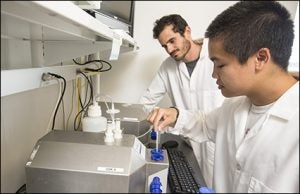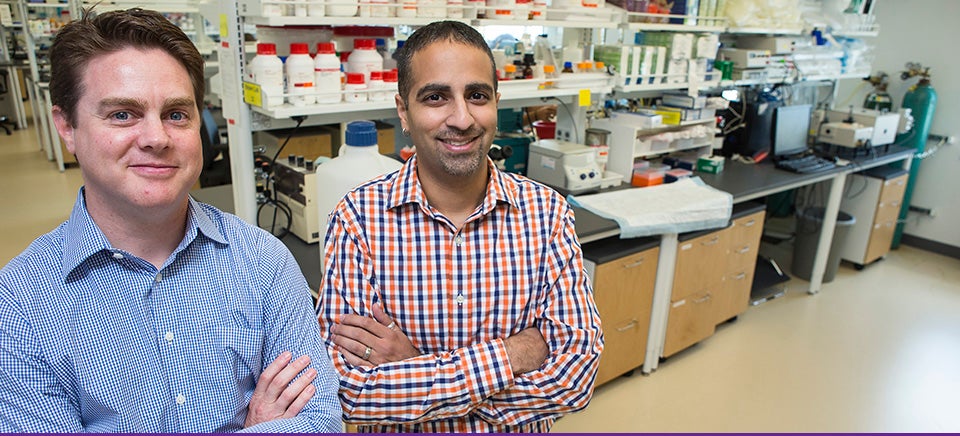HEART HEALTH
Collaborative research approach yields grant to investigate heart disease
Drs. David Brown and S. Raza Shaikh have very different scientific skill sets. They might never have met if not for a multi-disciplinary research group based at East Carolina University.
Brown, of the Department of Physiology, is an expert in mitochondria, which he frequently refers to as “the engine of the cell.” Shaikh, of the Department of Biochemistry, specializes in understanding the function of membranes and lipids. But their offices are side-by-side as partners in the East Carolina Diabetes and Obesity Institute.
Together, Brown and Shaikh recently landed a $366,744 grant from the National Institutes of Health to investigate new ways to protect the heart during a heart attack.

Grad student Rick Alleman, left, and medical student Alvin Tsang work together in the research lab.
During many pathological states – such as diabetes or following a heart attack – mitochondria don’t “breathe” as well as they do in the healthy state. The mitochondrial membrane, in particular, is destroyed by heart disease. So even if a patient survives a heart attack, the lasting damage to their cells is likely to lead to another incident.
“If we can figure out the mechanism by which cell death occurs, we can come up with therapies to prevent cell death,” Shaikh explained. “Our biophysical tools and (Brown’s) disease model is what we’ve mashed together.”
“It’s been a really fruitful collaboration,” Brown agreed, noting that the pair have written a handful of grants, published several papers, received industry funding and presented at international symposiums in 10 different countries.
This partnership is precisely what ECU researchers hoped for when they opened the fourth floor of the East Carolina Heart Institute building nearly a year ago. The space provides a physical home for the Diabetes and Obesity Institute.
“It was very much the intention of the fourth floor to create an interdisciplinary, collaborative atmosphere,” said Dr. Darrell Neufer, director of the institute. “The very design of the space – the open lab and offices format, the core spaces and equipment – ensures that lab principal investigators and their personnel will be bumping into each other all day, every day. That type of interaction generates new relationships and new ideas.”

Research team member Dr. Heather Teague works in the lab.
Neufer said he expects this will be the first of many collaborative successes to come out of the fourth floor in the next few years. And Brown and Shaikh said they are proud to be a part of it.
“Applying basic science to disease models,” Shaikh predicted, “that’s where science is headed.”
Their research also addresses a health dilemma with roots firmly planted in the region.
“Eastern North Carolina has among the highest rates of heart disease as anywhere in the country,” Brown said. “We think if we can keep the mitochondria healthy, we can keep hearts healthy.”
The UNC Board of Governors founded the Metabolic Institute in 2005 in response to the growing epidemic of diabetes and obesity in eastern North Carolina. The name was later changed in 2010 to its current designation, the East Carolina Diabetes and Obesity Institute.
Research at the institute encompasses fields including bariatric surgery, insulin signaling, glucose transport, bioenergetics, enzymology, retinoic acid metabolism, exercise physiology, pediatric healthy weight programs, dietary lipids, immunology, cardiac arrhythmia and many other areas.
